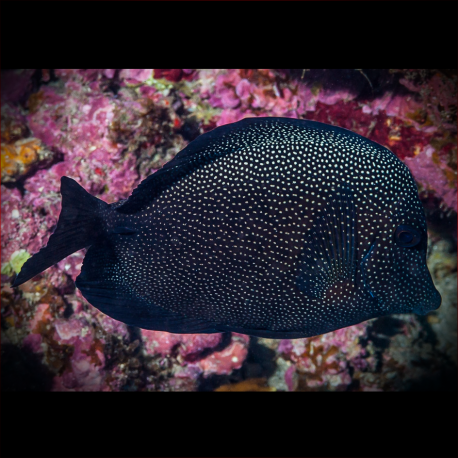More info
Datasheet
| Minimum Tank Size | 500 litres / 132.09 US gallons |
| Maximum Size | 22cm / 8.66inches |
| Reef Compatible | Always reef safe |
| Temperament | Might be aggressive towards similar species |
| Temperature | 22.2°C / 71.96°F - 25.6°C / 78.08°F |
| Specific Gravity | 1.020-1.025 |
| Carbonate Hardness | 8-12 |
| pH | 8.1-8.4 |
General Description
The Zebrasoma gemmatum, commonly known as the Spotted tang, belongs to the Acanthuridae family, specifically under the Zebrasoma genus. This Surgeonfish is a popular choice for coral aquariums due to its vibrant colors and relatively simple care requirements.
Aquarium Suitability
The Spotted tang is suitable for most aquarium setups, but caution should be exercised when housing them with similar species, as they may display aggression, especially when competing for space.
Demands, Care, and Hardiness
With average hardiness, the Spotted tang requires a tank size of at least 500 liters. It is crucial to provide hiding places, especially when initially introducing them to the aquarium. These fish thrive in a well-established tank with ample algae for grazing, supplemented by a diet rich in algae-based foods such as seaweed and spirulina.
Reef Suitability
The Spotted tang is always reef safe, seldom bothering corals or invertebrates, making it an excellent addition to a reef aquarium.
Aquarium Setup
When setting up an aquarium for the Spotted tang, ensure a temperature range between 22.2-25.6°C, a pH of 8.1-8.4, a specific gravity of 1.020-1.025, and a carbonate hardness (KH) of 8-12. Maintain a well-run tank with sufficient algae growth on rocks and stones for the tang to graze.
Behaviour
These Surgeonfish species spend most of their time swimming around and nibbling on algae. They establish hierarchies when kept with other Surgeonfish, with more aggressive species requiring added caution during introductions.
Feeding and Diet
The Spotted tang primarily feeds on small crustaceans such as krill, mysis, and artemia, but it is essential to maintain a diet rich in macroalgae and microalgae like spirulina for their overall health.
Habitat and Distribution
Native to the East Indian Ocean and West Indian Ocean, the Spotted tang thrives in reef environments, contributing to the balance by consuming algae and keeping the tank clean.

